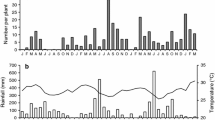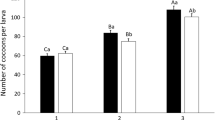Abstract
The biology of the bark beetle parasitoidRoptrocerus xylophagorum (Ratzeburg) from Georgia, U.S.A., was studied under controlled conditions in Australia. Parasitoids were presented withIps grandicollis Eichhoff in the isolated bark ofPinus radiata D. Don. Females lived up to 24 days at 24°C, and could parasitize up to 11 hosts in a single day. Usually only 1 egg was laid on each paralyzed host. Both larvae and pupae were parasitized, but the former appeared to be preferred. The species was arrhenotokous, and tended to produce more males when parasitizing smallerIps larvae. Males and females required 158Do and 179Do respectively, above a threshold of 13.8°C, to complete development, and their size was dependent on the host stage.
Insects in a 2nd culture ofRoptrocerus from California differed in appearance, although supposedly being the same species. A preliminary cross-breeding experiment provided evidence that the 2 cultures are reproductively isolated.
Résumé
La biologie du parasitoide de scolytes,Roptrocerus xylophagorum Ratzeburg, provenant de Georgie, Etats-Unis, a été étudiée en Australie dans des conditions contrôlées. Les parasitoides ont été mis en présence deIps grandicollis Eichhoff dans des troncs isolés dePinus radiata D. Don. Les femelles vivent jusqu' à 24 j. à 24°C et peuvent parasiter jusqu'à 11 insectes-hôtes dans la même journée. En général, 1 seul œuf est déposé par hôte paralysé. Aussi bien les larves que les nymphes sont parasitées mais les premières sont préférées. Cette espèce est arrhénotoque et a tendance à donner davantage de mâles en présence de larves d'Ips plus petites. Les mâles et les femelles demandent 150 degrés-jours et 179 degrés-jours respectivement, au-dessus du seuil de 13,8°C pour achever leur développement; leur taille est fonction du stade de l'hôte.
Dans un 2ème élevage lesRoptrocerus provenant de Californie avaient un aspect différent, bien qu'il s'agisse en principe de la même espèce. Des essais préliminaires de croisement ont mis en évidence que ces 2 populations sont isolées au point de vue reproduction.
Similar content being viewed by others
References
Ball, J.C. &Dahlsten, D.L. — 1973. Hymenopterous parasites ofIps paraconfusus [Coleoptera: Scolytidae] larvae and their contribution to mortality. I. Influence of host tree and tree diameter on parasitization. —Can. Entomol., 105, 1453–1464.
Beaver, R.A. — 1966. The biology and immature stages ofEntedon leucogramma (Ratzeburg) [Hymenoptera: Eulophidae], a parasite of bark beetles. —Proc. R. Entomol. Soc. Lond., (Fl) 41, 37–41.
Berisford, C.W. — 1974a. Parasite abundance inIps spp. infestations as influenced by the southern pine beetle. —Environ. Entomol., 3, 695–696.
Berisford, C.W. — 1974b. Hymenopterous parasitoids of the eastern juniper bark beetle,Phloeosinus dentatus [Coleoptera: Scolytidae]. —Can. Entomol., 106, 869–872.
Berisford, C.W. &Franklin, R.T. — 1971 Attack patterns ofIps avulsus andI. grandicollis [Coleoptera: Scolytidae] on four species of southern pines. —Ann. Entomol. Soc. Am., 64, 894–897.
Berisford, C.W., Kulman, H.M. &Pienkowski, R.L.: — 1970. Notes on the biologies of hymenopterous parasites ofIps spp. bark beetles in Virginia. —Can. Entomol., 102, 484–490.
Bushing, R.W.. — 1967. Parasites of the western pine beetle,Dendroctonus brevicomis Le Conte [Coleoptera: Scolytidae], with particular reference toRoptrocerus xylophagorum (Ratzeburg) [Hymenoptera: Torymidae] —Ph. D. Thesis Univ. California, Berkeley, 120 pp.
Cock, M.J.W. — 1978. The assessment of preference —J. Anim. Ecol., 47, 805–816.
Dahlsten, D. L. & Bushing, R.W.. — 1970. Insect parasites of the western pine beetle, pp. 113–118. In: Studies on the Population Dynamics of the Western Pine Beetle,Dendroctonus brevicomis Le Conte [Coleoptera: Scolytidae] (R.W. Stark & D.L. Dahlsten eds.). —Univ. California.
De Leon, D. — 1934. An annotated list of the parasites, predators, and other associated fauna of the mountain pine beetle in western white pine and lodgepole pine. —Can. Entomol., 66, 51–56.
Dix, M.E. &Franklin, R.T. — 1981. Observations on the behavior of the southern pine beetle parasiteRoptrocerus eccoptogastri Ratz. [Hymenoptera: Torymidae] —J. Georgia Entomol. Soc., 16, 239–248.
Franklin, R.T. — 1969. Hymenopterous parasites of the southern pine beetle in Georgia. —J. Georgia Entomol. Soc., 4, 119–122.
Gargiullo, P.M. &Berisford, C.W. — 1981. Effects of host density and bark thickness on the densities of parasites of the southern pine beetle. —Environ. Entomol., 10, 392–399.
Goyer, R.A. &Finger, C.K. — 1980. Relative abundance and seasonal distribution of the major hymenopterous parasites of the southern pine beetle,Dendroctonus frontalis Zimmermann on loblolly pine. —Environ. Entomol., 9, 97–100.
Graham, M.W.R. de V. — 1969. ThePteromalidae of north-western Europe [Hymenoptera: Chalcidoidea]. —Bull. Brit. Mus. (Nat. Hist.) Entomol., suppl. 16, Lond. 908 pp.
Krombein, K.V., Hurd, P.D. Jr, Smith, D.R., Burks, B.D. et al. — 1979. Catalog ofHymenoptera in America North of Mexico. Vol. 1.Symphyta and Apocrita (Parasitica). —Smithsonian Institution Press, Washington.
Mendel, Z. &Halperin, J. — 1981. Parasites of bark beetles [Col.: Scolytidae] in pine and cypress in Israel. —Entomophaga, 26, 375–379.
Morgan, F.D. — 1967.Ips grandicollis in South Australia. —Aust. For., 31, 137–155.
Ohmart, C.P. &Voigt, W.G. — 1982. Temporal and spatial arrival patterns ofIps plastographus maritimus [Coleoptera: Scolytidae], and its insect associates on freshly felledPinus radiata in California. —Can. Entomol., 114, 337–348.
Rao, S.V. &DeBach, P. — 1969. Experimental hybridization and an interpretation of evolutionary relationships among the species. —Hilgardia, 39, 515–553.
Reid, R.W. — 1957. The bark beetle complex associated with lodgepole pine slash in Alberta. Part II — Notes on the biologies of several hymenopterous parasites. —Can. Entomol., 89, 5–8.
Ryan, R.B. &Rudinsky, J.A. — 1962. Biology and habits of the Douglas-fir beetle parasite,Coeloides brunneri Viereck [Hymenoptera: Braconidae], in western Oregon. —Can. Entomol., 94, 748–763.
Wilkinson, R.C.. — 1963. Larval instars and head capsule morphology in three southeasternIps bark beetles. —Fla. Entomol., 46, 19–22.
Author information
Authors and Affiliations
Rights and permissions
About this article
Cite this article
Samson, P.R. The biology ofRoptrocerus xylophagorum [Hym.: Torymidae], with a note on its taxonomic status. Entomophaga 29, 287–298 (1984). https://doi.org/10.1007/BF02372116
Issue Date:
DOI: https://doi.org/10.1007/BF02372116




